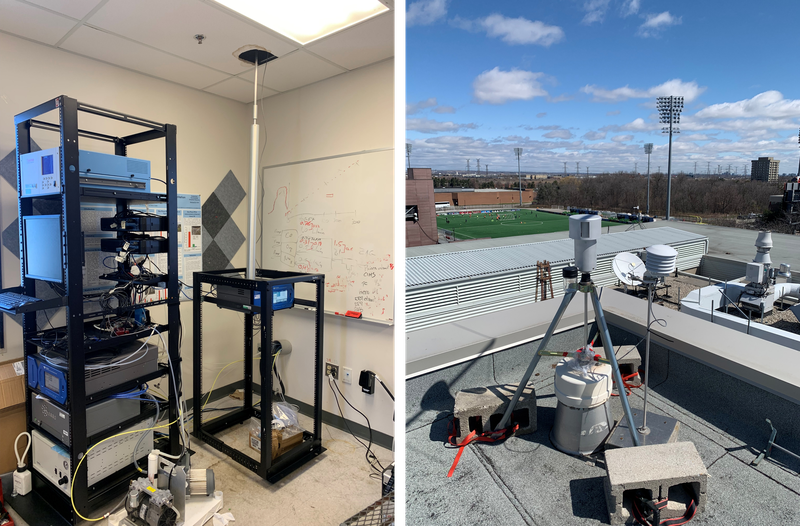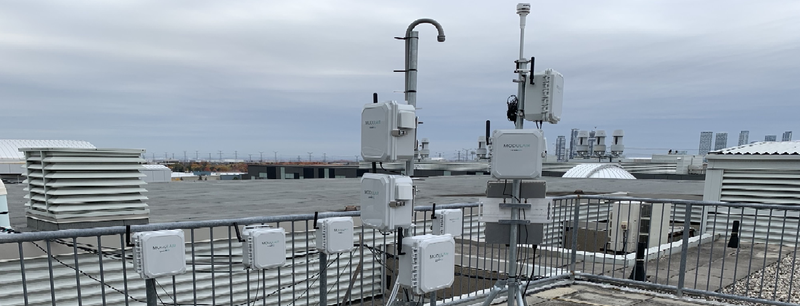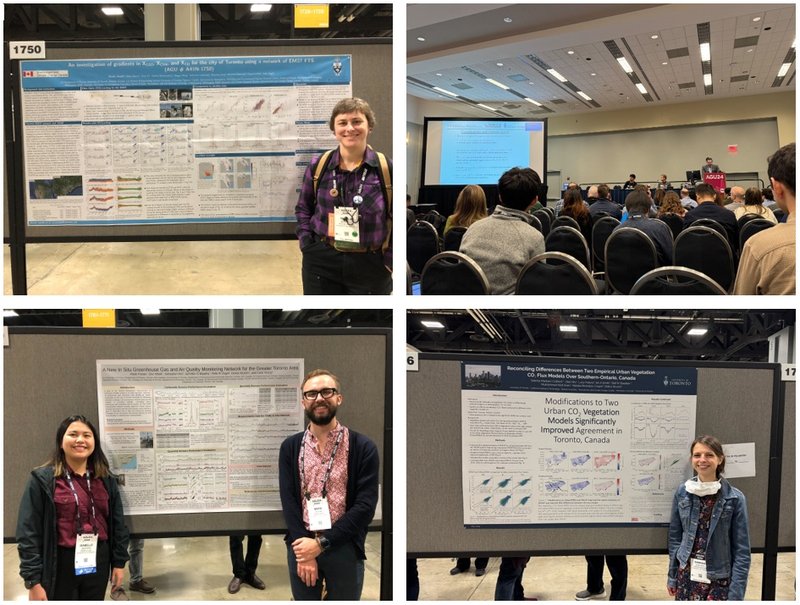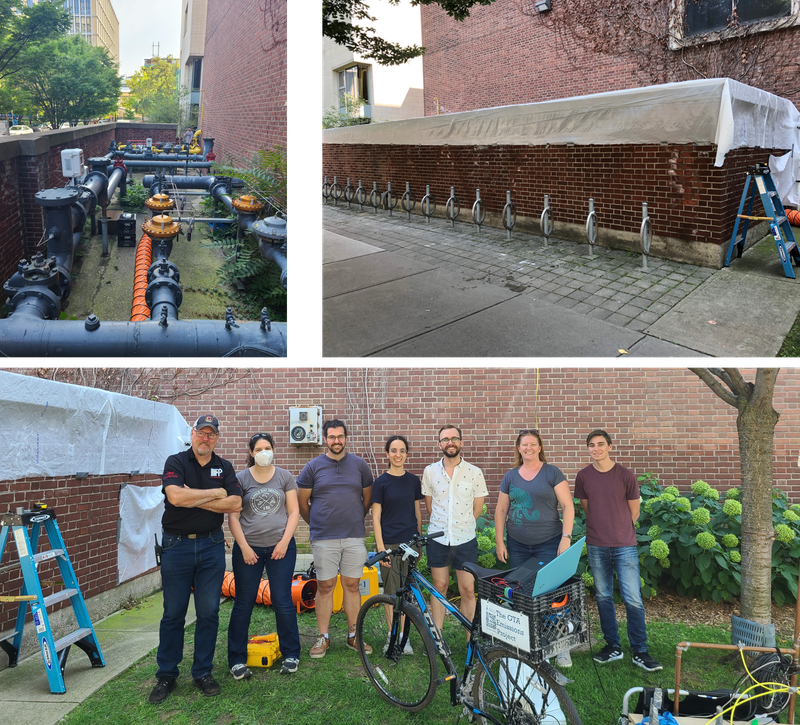June 15th, 2025 - TAME Mid-Project Meeting
On June 2, 2025, the TAME project team came together at the University of Toronto’s St. George campus for our Mid-Project Meeting. Held in the Davenport Room of the Chemistry Department, the event brought together colleagues from across our partner institutions, including the University of Toronto, York University, Environment and Climate Change Canada, The Atmospheric Fund, Kindred Works, KPMB Architects, and Hammerschlag & Joffe.
The day began with an update from Debra Wunch, who outlined project progress and set the stage for the discussions ahead. Presentations then followed from our highly qualified personnel (HQP), showcasing research across the project’s five central themes: greenhouse gas measurements, air quality measurements, carbon sequestration, refrigerants, and modelling. These talks highlighted both the scientific advances achieved to date.

We also welcomed a new group of summer students who are just beginning their projects, most of which will continue through the summer. The afternoon featured select presentations from collaborators, who shared perspectives that connected scientific results to building design, and urban policy.
The meeting concluded as we reflected on progress so far and defined the priorities that will guide us through the next year of the project. With new results, and renewed commitment, the Mid-Project Meeting marked a key milestone in our collective effort.
June 1st, 2025 - Tracking Fluorinated Gases in Heat Pump Systems: Understanding Emissions and Improving Measurement Techniques
As the adoption of heat pumps grows in Canada, so too does the importance of understanding the environmental trade-offs involved in their use. Heat pumps may offer a cleaner way to heat and cool our buildings, but they rely on synthetic refrigerants, which are potent greenhouse gases. Over time, even small leaks of these compounds could meaningfully contribute to atmospheric hydrofluorocarbon (HFC) levels.
TAME project researchers led by Dr. Cora Young at York University are working to quantify and better understand these leaks. The team is evaluating emissions of F-gases under real-world operating conditions using two strategies. First, they are analyzing specific HFCs (such as HFC-32, HFC-125, and HFC-134a) using gas chromatography-mass spectrometry (GC-MS), paired with a thermal desorption autosampler to quantify the content of each compound. Second, they are applying a new method to determine total fluorine content by converting all fluorinated compounds into hydrogen fluoride (HF) through a thermolysis process in the presence of propane. The HF is then measured using ion chromatography. This method, developed by the group at York, was recently published in Environmental Science & Technology Letters (Environ. Sci. Technol. Lett. 2024, 11, 1062−1067).
The project is being led on the ground by postdoctoral fellow Igor Pereira, who is overseeing experiment design, sampling, and data analysis. The broader team includes PhD student Stephen Ye, who developed the total F-gas system; undergraduate student Leo Tzerpos, who has contributed to hands-on measurements; and Dr. Young, who is responsible for the overall research direction.
Instrumentation setup and method development began in Spring 2024. Since then, the team has been refining sampling methods, testing a variety of sample containers including Tedlar bags, foil bags, and canisters, and evaluating how portable their analytical systems are for use in the field. As of early 2025, method optimization is complete, and the team is shifting toward analyzing samples from building systems.
On the Horizon
As heat pumps continue to play a central role in Canada’s climate strategy, the ability to monitor and manage refrigerant leakage will become increasingly vital. The tools and approaches being developed through this work will enable robust, ongoing assessment of F-gas emissions from the built environment. These insights will help to support improvements in maintenance practices, and regulatory design.
This effort feeds directly into the broader goals of the TAME project. By accounting for the role of synthetic refrigerants, alongside greenhouse gases, air pollutants, and carbon sequestration, this work helps build a more complete picture of emissions in Toronto and supports informed, evidence-based climate action at the local level.
May 29th, 2025 - Advancements in Toronto’s EM27 FTS Network
Measuring greenhouse gas concentrations at multiple spatial scales is critical for evaluating urban emissions and tracking changes over time. Since 2017, the University of Toronto has supported the operation of a network of EM27 FTS instruments across five Toronto sites, capturing total column concentrations of CO₂, CH₄, and CO. The EM27s FTS measures incoming solar radiation in the near infrared and then a retrieval algorithm is applied to translate the solar radiances into estimates of trace gas concentrations. Unlike satellites, which provide spatial snapshots infrequently, the EM27 network generates continuous data (weather permitting) from fixed locations. The result is a high-density, long-duration data record that can detect seasonal patterns, assess emission trends over time, and offer direct comparisons to satellite and model outputs. Within the TAME project, these regional-scale measurements are complemented by finer-scale observations from in situ sensors and mobile platforms, enabling a multi-scale analysis of Toronto’s carbon dynamics. Automation and system stability are key to the success of this network, which will improve data density and reduce the operational burden associated with manual oversight.
Automating Data Collection
In recent years, a key challenge for the EM27 network has been maintaining consistent data collection. Originally housed in automated domes, the instruments were designed for remote operation. However, by 2023, most of these domes were no longer functional, requiring manual intervention at each site. This is a major limitation given staffing constraints.
To address this, Nicole Jacobs, who took over management of the network near the end of 2023, led the deployment of a new solar tracking system . The updated setup replaces the old mirror-based trackers with a telescope and fiber optic system, allowing the spectrometer to remain protected indoors while continuously capturing sunlight. This shift not only improved data continuity but also reduced the risk of weather-related damage.
The transition required careful experimentation. The team tested multiple fiber lengths and optical materials before settling on 2-meter metal-sheathed fibers and CaF₂ lenses, which offer better transparency in the near-infrared range. Alignment also proved challenging and was refined with guidance from collaborators at the University of Wollongong. The success of this work has been built on the contributions from multiple team members. Nasrin Mostafavi Pak, who led the original network deployment during her PhD, helped establish the five Toronto sites. Lawson Gillespie, a current PhD student, supported early maintenance and operations. To test the automation concept, Nicole worked with a talented group of undergraduate engineering students including Shiqi Xu, Kapilan Bavananthan, Maggie Wang, and Katherine Latosinsky, who developed a functional prototype ahead of the rollout. Guidance from colleagues at Wollongong (Nicholas Jones, Nicholas Deutscher, and David Griffith) was critical throughout the process.
Ongoing Improvements
In February 2025, snow infiltration at the UTSG site confirmed the need for fully enclosed, climate-controlled housings. A new enclosure was recently installed and is performing well so far. This transition to automated, durable monitoring is essential for generating long-term, and robust datasets . With a reliable network in place, the project can continue to generate high-quality, city-scale greenhouse gas data to inform models, validate satellite observations, and support evidence-based climate policy in Toronto.
May 5th, 2025 - The TAME Project's Calibration Facility is Now Operational
We are excited to share a significant milestone in the TAME project: the successful establishment of our calibration facility, located at York University. This facility plays a central role in ensuring the reliability of the TAME low-cost sensor network and is a major step forward in our mission to monitor urban air quality with high spatial resolution.
Why Calibration Matters
The TAME project depends on a growing network of low-cost sensors to collect data on key pollutants such as carbon dioxide (CO₂), carbon monoxide (CO), nitrogen oxides (NOₓ), ozone (O₃), and particulate matter (PM₂.₅ and PM₁₀). These sensors are cost-effective and scalable, but their measurements can be influenced by environmental conditions like temperature and humidity. To ensure accuracy and consistency across the network, each sensor must be carefully calibrated against trusted reference instruments.
A Purpose-Built Laboratory
Our new calibration facility at York University allows us to do just that. In this laboratory setting, we co-locate our low-cost QuantAQ and Carbonode sensors with high-precision, reference-grade instruments that continuously sample outdoor air. This setup enables us to characterize the performance of the sensors under real-world environmental conditions and apply corrections that improve their accuracy.

The instruments in operation include:
Picarro G2401 – measuring carbon dioxide (CO₂) and carbon monoxide (CO)
Thermo 49i Ozone Analyzer – measuring ozone (O₃)
Teledyne T200U – measuring nitrogen oxides (NOₓ)
Teledyne T640 – recently added to measure both PM₂.₅ and PM₁₀ mass concentrations
The inclusion of the T640 has been particularly important, allowing us to now assess particulate measurements from the QuantAQ sensors with high confidence.

Timeline and Team Effort
Work on the facility began in the summer of 2024. By August, most of the instruments were operational, and the facility has been steadily collecting data ever since. This achievement is the result of significant technical effort and collaboration:
-Mark Panas led the development of the calibration facility, overseeing its design, instrumentation, and day-to-day operation
-Eric Ward has played a key role in setup and ongoing maintenance
-Alexandra Corapi and Toshi Tall contributed to the initial setup
-Isabelle Lao and Eric Ward are leading data analysis
-Igor Pereira has provided logistical coordination
We would like to thank Felix Vogel and his team at ECCC who designed the low-cost CO2 sensors, and loaned us the Picarro instrument. We also wish to extend our gratitude to Prof. Cora Young and Prof. Trevor VandenBoer, and the broader team at York University, for their ongoing support in maintaining the laboratory space.
Looking Ahead
With the calibration facility now fully operational, the TAME project is well-positioned to scale up its sensor deployments across Toronto. The ability to ground our measurements in trusted reference data is essential for delivering high-quality insights into urban air pollution, and this facility provides the backbone for that effort.
Stay tuned as we continue to grow the network, refine our models, and share what we learn about the air we breathe.
February 15th, 2025 - Investigating Cold-Start Emissions in Toronto: A Collaborative Study with ECCC
Researchers from the TAME project (Environment and Climate Change Canada (ECCC) the University of Toronto) are actively studying cold-start emissions—vehicle emissions that occur before the engine and catalytic converter reach optimal operating temperatures. As emission control technologies improve, these cold-start events are becoming an increasingly significant proportion of non-CO₂ vehicle emissions, particularly in urban environments like the Greater Toronto Area (GTA).
To better understand the spatial and temporal distribution of these emissions, the team has been conducting field measurements at key locations, including the Streetsville GO Station and parking garages at the University of Toronto’s McLennan Physical Laboratories (MP) and Bahen Centre. Using air quality sensors, the researchers are continuously collecting data on carbon monoxide (CO) and carbon dioxide (CO₂) levels to assess how vehicle cold starts contribute to urban air pollution.
Preliminary results were recently presented by Alex Corapi at the SWAPIT Workshop, on January 28, 2025. Of particular interest, we observed notable spikes in CO emissions, particularly during evening commuting hours when many vehicles undergo cold starts. At the MP garage, a specialized peak-finding algorithm has identified thousands of emission events, providing valuable insights into emission patterns and plume durations. By combining these datasets with ongoing seasonal measurements, the research team aims to refine urban pollution models and inform future mitigation strategies.
As the study progresses, the team will continue analyzing data across different seasons and locations to build a more comprehensive understanding of cold-start emissions and their impact on the environment.

December 15th, 2024 - TAME at AGU: Sharing Innovations in Atmospheric Monitoring
Members of the Toronto Atmospheric Monitoring of Emissions (TAME) project recently attended the American Geophysical Union (AGU) 2024 Annual Meeting in Washington, D.C. The AGU conference is the largest gathering of earth and atmospheric scientists globally, which provided an excellent opportunity to share the team’s work and connect with other leaders in the field.
TAME members shared their work through two talks and three posters, highlighting the project’s advancements in urban greenhouse gas and air quality monitoring. Debra Wunch delivered an invited talk showcasing the development of Toronto’s comprehensive greenhouse gas monitoring network. Lawson Gillespie presented a comparative study on methodologies for quantifying methane emissions from landfills.
In the poster sessions, Nicole Jacobs shared insights into atmospheric gradients in Toronto using an advanced REMOTE SENSING spectrometer network, while Sabrina Madsen explored urban vegetation’s role in carbon dioxide sequestration. Mark Panas showcased the establishment of a new in situ greenhouse gas and air quality monitoring network for the Greater Toronto Area.
Beyond the presentations, the AGU conference served as a platform for engaging with researchers, policymakers, and industry stakeholders. The TAME team participated in discussions on urban emissions, technological innovation, and policy integration, fostering new connections and collaborative opportunities. This advanced the project’s visibility but also reaffirmed the importance of scientific collaboration in tackling the challenges of urban emissions.

Talks:
- Gillespie, L. D., Ars, S., Fraser, S., Vogel, F., and Wunch, D.: Comparing Methodologies for Quantifying Landfill Methane Emissions. Talk, American Geophysical Union 2024, Washington, D.C., 2024.
- Wunch, D., Murphy, J., Jones, D., Vogel, F., Panas, M., DiMaria, C., Ward, E., Madsen, S., Zhao, X., Young, C., Weaver, D., Ars, S., Jacobs, N., Restrepo-Coupe, N., Da Silva, I., Gillespie, L., and Corapi, A.: An Observatory to Monitor Greenhouse Gas Emissions and Air Quality in Toronto, Canada. Talk (Invited), American Geophysical Union 2024, Washington, D.C., 2024.
Posters:
- Jacobs, N., Xu, S., Bavananthan, K., Wang, M., Latosinsky, K., Jones, N., Deutscher-Coupe, N., Griffith, D., and Vogel, F.: An Investigation of Gradients in XCO2, XCH4, and XCO for the City of Toronto Using a Network of EM27 FTS. Poster, American Geophysical Union 2024, Washington, D.C., 2024.
- Madsen, S., Wu, D., Hutyra, L., Smith, I., Staebler, R., Arain, M., Restrepo-Coupe, N., and Wunch, D.: Reconciling Differences Between Two Urban Vegetation CO2 Models Over Southern Ontario, Canada. Poster, American Geophysical Union 2024, Washington, D.C., 2024.
- Panas, M., Ward, E., Ars, S., Murphy, J., Vogel, F., Wunch, D., and Young, C.: A New In Situ Greenhouse Gas and Air Quality Monitoring Network for the Greater Toronto Area. Poster, American Geophysical Union 2024, Washington, D.C., 2024.
August 26th, 2024 - The Steam Plant Emissions Experiment
Members of the TAME project at the University of Toronto embarked on a project to measure methane emissions from the fenced area surrounding the Central Steam Plant on Ursula Franklin Street. This area is home to both Enbridge natural gas pipes and the university's own infrastructure. By sealing the enclosure with fire-retardant poly sheeting and using advanced sensors, the team gathered data on methane levels over several hours. The results revealed a significant enhancement in methane concentrations, indicating a noteworthy level of emissions.
These findings highlight the importance of regular maintenance in managing emissions. The potential costs associated with lost methane can add up, making it essential to address these issues proactively. When considering the broader social costs of methane emissions, the impact becomes even more pronounced.
As a potent greenhouse gas, reducing methane emissions is crucial for combating climate change. The research team will conduct further studies throughout different seasons to gain a better understanding of seasonal emission variability. This initiative reflects a positive step forward in promoting sustainability on campus.

